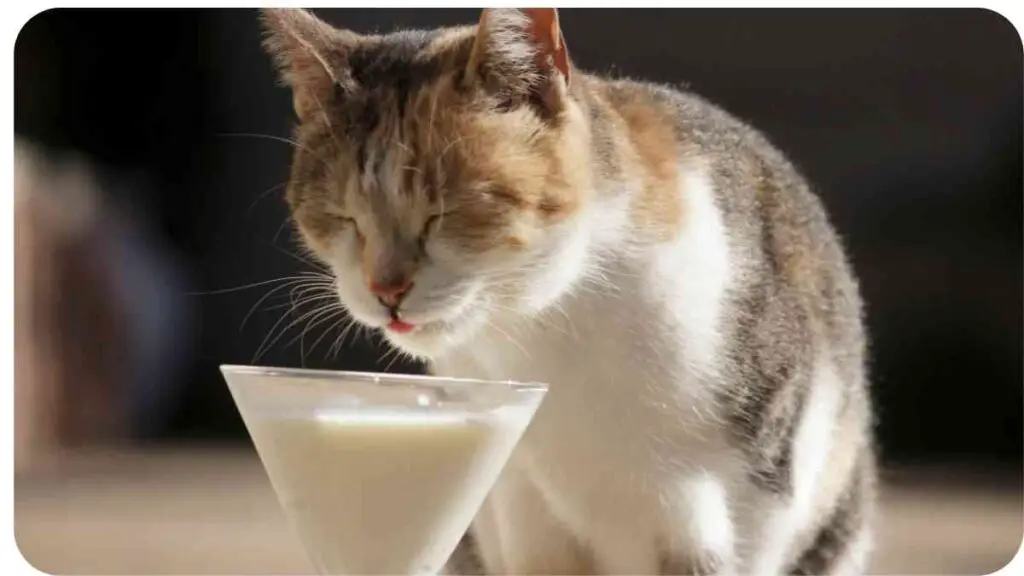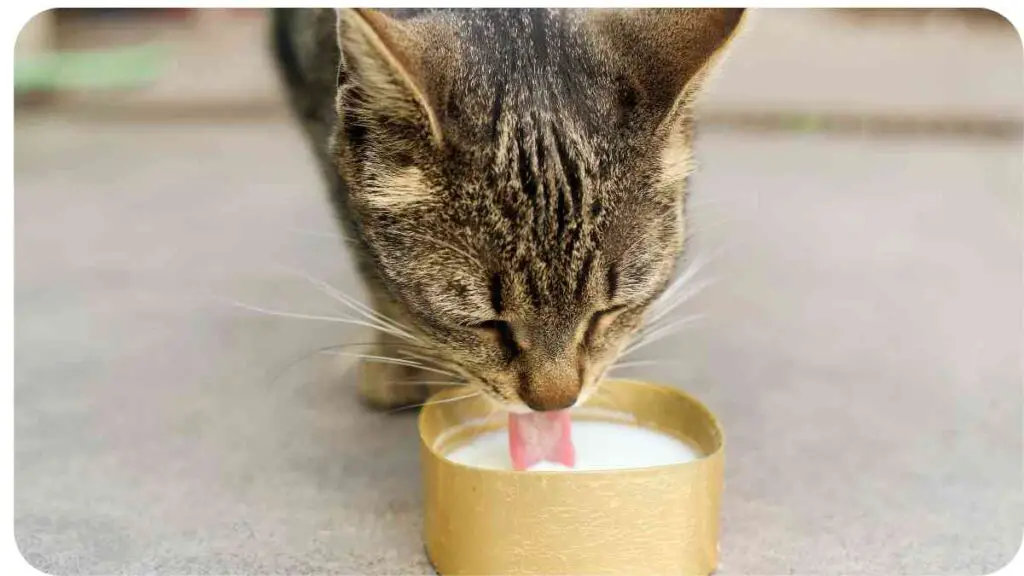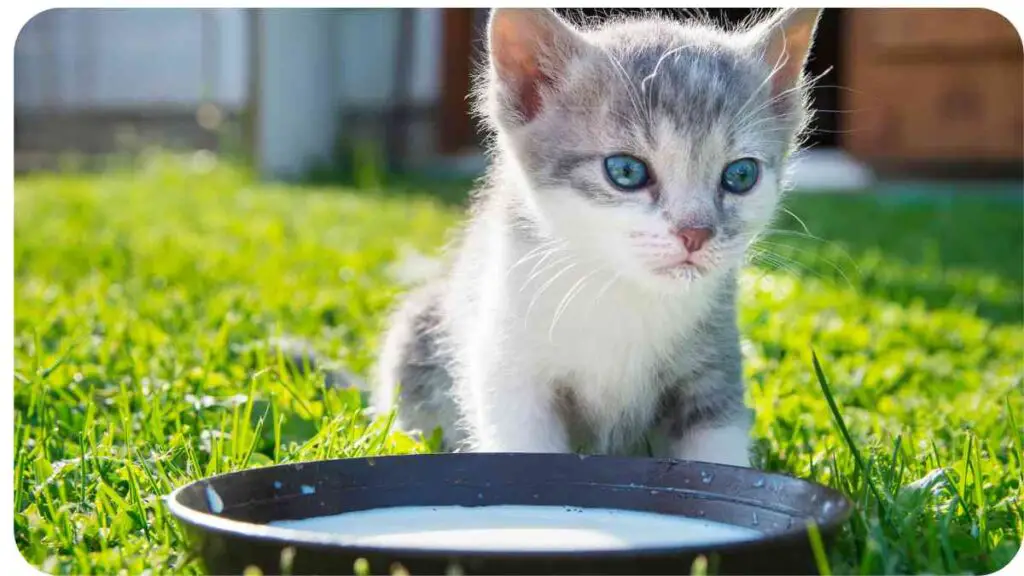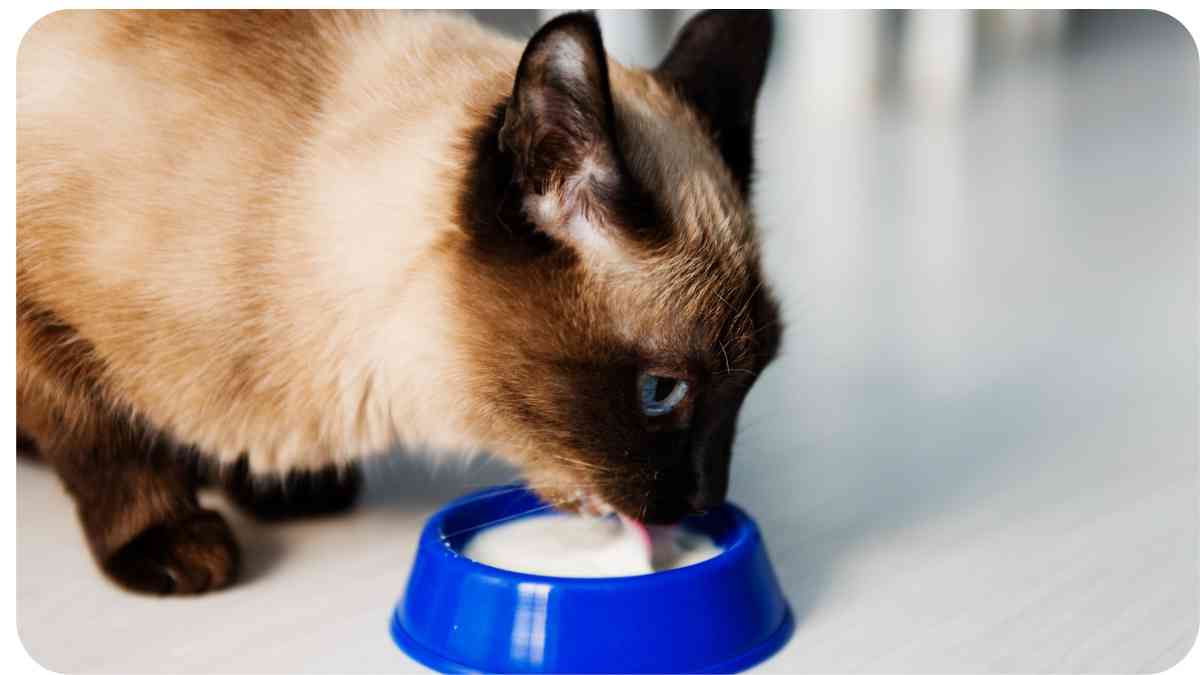Curious about whether your Siamese cat can enjoy a bowl of milk? Unravel the truth behind feline lactose tolerance and discover safe alternatives in this guide.
From specialized cat milk to understanding your cat’s preferences, we explore the ins and outs of offering milk to your Siamese companion. Let’s delve into the myths, realities, and essential considerations for a balanced and cat-friendly diet.
| Takeaways |
|---|
| Feeding milk to Siamese cats requires careful consideration. |
| Siamese cats may be lactose intolerant, so regular milk can be risky for them. |
| Specialized cat milk or lactose-free milk can be safer alternatives. |
| It’s essential to monitor your Siamese cat’s reaction to milk and consult a veterinarian for personalized advice. |
| Factors like age, health condition, and individual tolerance should be taken into account when considering milk for Siamese cats. |
Understanding Feline Preferences

Contrary to popular belief, most cats don’t have an inherent liking for milk. Unlike dogs, cats have not evolved to consume dairy products as a natural part of their diet. In fact, a significant number of cats, including the graceful Siamese breed, are lactose intolerant, making milk digestion challenging.
Factors influencing a cat’s aversion to milk vary. Some cats, especially those carrying excess weight, may exhibit a low thirst drive, contributing to disinterest in liquids. Additionally, feline stomach sensitivities can cause discomfort after consuming milk or other dairy items. For Siamese cats, notorious for a potential aversion to water, finding alternative methods to boost fluid intake becomes paramount.
Feeding a Siamese cat requires special considerations due to their delicate nature. If you want to ensure a balanced diet for your Siamese companion, check out our article on meeting the dietary needs of Siamese cats for expert tips and recommendations.
Understanding Feline Desires
Discovering whether your cat desires milk involves respecting their independent nature. Most cats, being highly independent animals, do not appreciate being coerced into activities they find unappealing, such as force-feeding. If your feline companion has consistently shown disinterest in any form of milk, attempting to introduce it may not yield positive results.
Observing your cat’s voluntary interest is key. If they are intrigued by the idea of trying this new beverage, they will communicate it by approaching the bowl and engaging in the act of licking. On the contrary, if your cat displays disinterest, it’s crucial not to force the introduction, as it may lead to potential digestive issues in the future. Respecting your cat’s preferences is essential for a harmonious relationship and their overall well-being.
| Signs Your Cat Wants It | |
|---|---|
| Food | Enthusiastically eats, purrs, meows for more |
| Toys | Engages actively, paws at toys, chases, or plays |
| Attention | Seeks physical contact, rubs against you, meows for attention |
| Resting Spots | Chooses the spot willingly, kneads or purrs while settling |
| Treats | Shows excitement, eagerly accepts and consumes treats |
| Brand Examples | N/A (Brand-specific behaviors may vary) |
Deciphering Feline Desires
Decode your cat’s desires by paying attention to their subtle cues. The table above outlines key indicators that reveal whether your feline friend wants something. In the realm of food, signs such as enthusiastic eating, purring, or meowing for more signal their interest. Engaging in active play, including pawing, chasing, or playing, demonstrates curiosity about toys.
When seeking attention, your cat may express it through physical contact, rubbing against you, or vocalizing their desire. Observing their choice of resting spots, coupled with behaviors like kneading or purring while settling, indicates their preferences. Excitement, eager acceptance, and consumption of treats highlight a desire for these indulgences.
It’s important to recognize that specific behaviors may vary based on individual preferences, and understanding these nuances fosters a stronger bond between you and your feline companion.
Navigating Feline Milk Consumption

While the majority of cats do not require milk in their diet, certain breeds can tolerate small amounts safely. Notably, breeds like Siamese and Burmese exhibit a higher lactose tolerance, thanks to a genetic mutation enabling them to digest lactose and produce the essential enzyme lactase.
For cats outside these specific breeds, it’s generally advisable to refrain from offering any dairy products. Lactose intolerance or allergies may pose risks. If your feline companion has a penchant for milk but faces lactose intolerance or dairy allergies, consider exploring alternative sources of calcium. Catnip tea emerges as a viable option, providing not only calcium but also essential vitamin D to support digestion and overall well-being.
If you’re considering shaving your Siamese cat, it’s crucial to understand the implications. Our veterinary expert answers your questions about shaving Siamese cats and provides essential insights to help you make an informed decision.
Choosing the Right Milk for Your Cat
While cow’s milk is a permissible choice for your cat, it’s essential to explore alternative options for a well-rounded feline diet. Avoiding certain types of milk is crucial to safeguard your cat’s health:
- Soy or Almond Milk: These alternatives may contain allergens that could potentially harm your cat. Opting for feline-specific milk ensures a safer choice.
- Rice Milk: With limited nutritional value, rice milk may not provide the essential nutrients your cat needs. Choosing nutrient-rich alternatives is vital for their well-being.
- Coconut Milk: While tasty, coconut milk’s high saturated fat content makes it less suitable for regular feline consumption. Moderation is key if offering this option.
- Goat’s Milk: Despite being an animal milk, goat’s milk contains lactose sugar, posing a challenge for cats, especially those with lactose intolerance. Consider lactose-free alternatives.
- Condensed Milk: This sweetened, thickened product is not suitable for feline consumption. Stick to options designed for cats to ensure their nutritional needs are met.
Determining the Right Milk Portions for Your Cat
The quantity of milk suitable for your cat depends on various factors such as age, size, and individual nutritional requirements. Here are key considerations to guide you:
- Gradual Introduction: Begin by offering a small amount of milk and gradually increase it over time. This gradual approach allows your cat to adjust to the new addition to their diet.
- Weight-Based Guidelines: While some suggest a general rule of 1 tablespoon per pound of body weight per day, this may not apply universally. Kittens and adult cats have different nutritional needs. For instance, a 5-pound kitten may thrive on as little as one teaspoon (5 ml) of whole cow’s milk per day, while an 8-pound adult Siamese might require approximately 2 tablespoons (30 ml).
- Body Condition Score (BCS): Monitoring your cat’s body condition score offers valuable insights into their overall health and nutritional status. Your veterinarian can assess this during regular check-ups or annual exams. A healthy BCS typically ranges from 5 to 9 out of 10, considering factors like coat condition and muscle tone.
Debunking the Myth
Contrary to popular belief, there’s little reason to include dairy products in your cat’s diet, especially if they are not lactose intolerant. Several compelling reasons support this stance:
- Digestive Discomfort: Dairy can lead to gastrointestinal issues in cats, including diarrhea, gas, and upset stomach. Many adult cats lack the necessary enzymes to efficiently process lactose, the sugar found in milk.
- High Fat Content: Dairy products are generally high in fat, which poses a risk of obesity over time. Maintaining a healthy weight is crucial for a cat’s overall well-being.
- Potential Nutrient Deficiencies: Accidental ingestion of dairy by kittens may result in anemia due to Vitamin B12 and taurine deficiencies. Additionally, calcium deficiency and the formation of kidney stones are potential concerns.
During pregnancy and nursing, Siamese cats have unique nutritional needs. To ensure the health and well-being of your pregnant or nursing Siamese cat, it’s important to understand the duration of their pregnancy. Check out our article on how long Siamese cats stay pregnant to learn more about this crucial period.
Balancing Dairy Intake
While dairy products can offer nutritional benefits to your Siamese cat, it’s crucial to maintain moderation to prevent potential side effects. Here’s what you need to know:
- Diarrhea: Excessive dairy consumption can lead to digestive upset, manifesting as diarrhea in cats. Monitoring their intake helps prevent gastrointestinal discomfort.
- Weight Gain: Dairy products are calorie-dense and high in fat, contributing to weight gain if consumed excessively. Maintaining a healthy weight is vital for your cat’s overall health and well-being.
- Constipation: In some cases, an imbalance in dairy consumption may result in constipation, leading to discomfort and potential health complications. Regulating intake is key to avoiding this issue.
- Gas and Bloating: Overindulgence in dairy can cause gas and bloating in cats, leading to discomfort and, in severe cases, pain. Limiting dairy intake helps prevent gastrointestinal distress and maintains your cat’s comfort.
| Side Effects | |
|---|---|
| Digestive | Lactose intolerance, bloating, gas |
| Weight-related | Weight gain, increased body fat |
| Skin | Acne, increased oil production |
| Allergies | Allergic reactions, such as hives or eczema |
| Bone health | Potential negative impact on calcium balance |
| Brand Examples | N/A (Brand-specific effects may vary) |
Exploring Healthier Alternatives
Opting for non-dairy alternatives can contribute to your cat’s well-being, offering a variety of choices. Consider the following alternatives to cow’s milk:
- Soy Milk: A plant-based option, soy milk is lower in fat compared to cow’s milk and can be a suitable alternative for your cat’s diet.
- Almond Milk: Almond milk is another alternative with lower fat content. Introducing this option can be beneficial for your cat’s health.
- Coconut Milk: With a distinct flavor, coconut milk provides a flavorful alternative. It is lower in fat, offering a lighter option for your cat.
These alternatives are considered better for your cat’s long-term health due to their reduced fat content and lesser likelihood of causing stomach upset. If you prefer a milk-like consistency similar to cow’s milk, consider diluting whole or skim versions with water. This practice ensures easier digestion for your cat, allowing them to enjoy a variety of flavors without compromising their overall health.
Keeping track of the growth and development of your Siamese kitten is essential. If you’re wondering about the ideal weight for a 3-month-old Siamese kitten, our guide on Siamese kitten weight at 3 months provides valuable information and guidelines to ensure your kitten’s health and proper nutrition.
Caution with Almond Milk

While almond milk may be a popular choice for humans seeking dairy alternatives, it is not advisable for cats. Here’s why:
- Incomplete Protein Source: Almonds lack the complete protein profile found in animal-based sources like cow’s milk. Cats require essential amino acids from their diet, and almond milk may not adequately fulfill these nutritional needs.
- Nutrient Disparities: Almond milk does not offer the same nutrient composition as cow’s milk or specialized cat formulas. Cats have unique dietary requirements, and almond milk may not provide the essential nutrients they need for optimal health.
- Consideration for Special Nutritional Needs: Cats with specific health conditions, such as diabetes, may have special nutritional requirements. Almond milk may not align with these needs, making it an unsuitable choice.
Choosing the Right Nutrition for Your Kitten
While it’s tempting to shower kittens with affection and treats, cow’s milk isn’t the best choice for their delicate digestive systems. Here’s why:
- Lactose Intolerance: Kittens lack the necessary enzymes to effectively digest lactose, the sugar present in cow’s milk. Feeding them cow’s milk can lead to digestive upset and discomfort.
- Nutritional Requirements: Kittens have specific nutritional needs crucial for their growth and development. Cow’s milk doesn’t provide the essential nutrients in the right proportions, making it an inadequate choice for their diet.
- Harmful Additives: Cow’s milk from grocery stores may contain additives harmful to kittens. Opting for specially formulated kitten formula, available at veterinary clinics or pet stores, ensures that your kitten receives the appropriate nutrition without harmful additives.
Choosing Wisely
Feeding your kitten cow’s milk can have adverse effects, potentially leading to diarrhea, illness, and even anemia due to blood loss. Here are key considerations when deciding between cow’s milk and formula for your kitten:
- Digestive Concerns: Cow’s milk is likely to cause digestive issues in kittens, including diarrhea and overall discomfort. Opting for a specialized formula ensures proper digestion and minimizes potential health issues.
- Anemia Risk: The ingestion of cow’s milk may pose a risk of anemia for kittens, emphasizing the importance of selecting a nutritionally appropriate alternative.
- Safe Feeding Practices: If you are already feeding your kitten a formula designed specifically for kittens, it is safe to continue with this choice. However, it’s crucial to follow the instructions on the formula packaging. If the formula specifies that it is not suitable for kittens under 12 weeks or requires dilution with water for nutritional balance, avoiding cow’s milk is advisable.
| Cow’s Milk | Kitten Formula | |
|---|---|---|
| Nutritional | Inadequate | Specifically formulated for kittens |
| Composition | Different from feline milk | Mimics the composition of mother cat’s milk |
| Digestibility | Hard for kittens to digest | Easily digestible by kittens |
| Essential Nutrients | Lacking in essential nutrients for kittens | Contains essential nutrients for proper growth and development |
| Brand Examples | Various cow’s milk brands | Brand-specific kitten formula options |
Final Thoughts on Milk for Your Siamese Cat
In conclusion, providing milk to your Siamese cat is not a dietary necessity. While milk contains calcium and protein, there are alternative ways to meet your cat’s nutritional needs without resorting to milk consumption. Consider the following key points:
- Lactose Intolerance: Cats are generally lactose intolerant, and feeding them regular milk may lead to digestive issues. However, some cats can tolerate raw or low-lactose milk products like yogurt.
- Diversified Nutrition: Wet food with high-quality protein sources such as chicken or tuna serves as a nutritious alternative to milk. It provides essential nutrients while catering to your cat’s dietary preferences.
- Delightful Treats: Treats like salmon jerky and freeze-dried liver treats offer a tasty and enjoyable way to reward your Siamese cat without relying on milk.
As Siamese cats age, their coats undergo natural changes. If you’re curious about whether Siamese cats’ coats darken with age and what factors influence these changes, our comprehensive article on Siamese cat coat changes with age explores the topic in detail, shedding light on this intriguing phenomenon.
Conclusion
In wrapping up, it’s clear that while milk can be a tempting treat, it’s not a dietary essential for Siamese cats. The understanding that many cats, including Siamese breeds, may be lactose intolerant emphasizes the need for alternative and cat-friendly nutrition.
Exploring options like non-dairy alternatives such as almond or coconut milk provides a spectrum of choices, accommodating various preferences and potential dietary concerns. However, regardless of the chosen diet, a crucial aspect remains vigilant monitoring of your Siamese cat’s health and portion control. Overfeeding, even with seemingly harmless treats like dairy, can lead to adverse effects.
In your journey of caring for your Siamese cat, remember that individualized attention, regular consultations with your veterinarian, and a diversified diet contribute to their overall well-being. By prioritizing their unique needs and preferences, you ensure a nourishing and enjoyable life for your cherished feline companion. Here’s to many happy and healthy moments together!
Further Reading
Here are some additional resources for more information about Siamese cats and their dietary needs:
Can Siamese Cats Drink Milk?: This FAQ article provides insights into whether it is safe for Siamese cats to consume milk and discusses the potential risks and considerations.
Can Siamese Cats Drink Milk?: This informative article explores the topic of Siamese cats and milk, covering the benefits, risks, and alternatives to consider.
Siamese Cat Food: Nutrition Tips and Recommendations: This comprehensive blog post offers valuable advice on selecting the right food for Siamese cats, taking into account their unique nutritional requirements.
FAQs
Here are some frequently asked questions about Siamese cats and milk:
Can Siamese cats drink milk?
Siamese cats can drink milk in moderation, but it is important to note that many cats are lactose intolerant. Some Siamese cats may tolerate milk better than others, but it is generally safer to offer lactose-free milk or specialized cat milk as an alternative.
What are the risks of feeding regular milk to Siamese cats?
Feeding regular milk to Siamese cats can lead to digestive upset, including diarrhea and stomach discomfort. This is because most adult cats lack the enzyme necessary to break down lactose, the sugar found in milk.
Are there alternatives to milk for Siamese cats?
Yes, there are alternatives to milk for Siamese cats. Specialized cat milk, available at pet stores, is formulated to be lactose-free and can be a safer option. Additionally, providing fresh water and a balanced diet that meets their nutritional needs is essential for Siamese cats’ health.
How can I introduce milk to my Siamese cat’s diet?
If you want to introduce milk to your Siamese cat’s diet, start by offering a small amount and observe their reaction. Monitor for any signs of digestive issues or discomfort. It is advisable to consult with a veterinarian before making any significant changes to your cat’s diet.
What other factors should I consider when feeding milk to Siamese cats?
When considering feeding milk to Siamese cats, it’s important to consider their age, health condition, and individual tolerance. Kittens may have a better ability to digest milk, but it’s still crucial to monitor their response. Always consult with a veterinarian for personalized advice regarding your Siamese cat’s dietary needs.

I’m Dr. Hellen James, a veterinarian who has spent her career working with cats and has seen firsthand how important it is to understand each breed’s unique needs.


